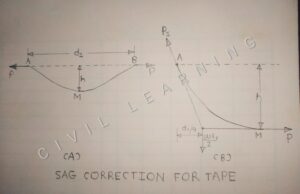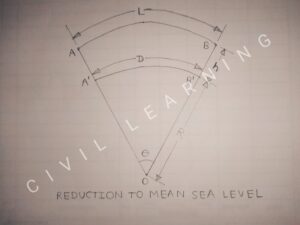The chain surveying is done by tape. But there are expected to have some errors because of inaccurate tape measurements. In normal chain surveys, errors are neglected. But for important survey work, precise tape corrections should be provided.
In this article, we will explain different corrections provided for tape measurements while performing chain surveying. The tape correction is a positive if the faulty length is to be increased and the tape correction is a negative if the faulty length is to be decreased.
Tape Corrections in Surveying
The tape corrections used for common errors in linear tape measurements are given below.
- Correction for actual length
- Correction for pull
- Correction for temperature
- Correction for sag
- Correction for slope
- Correction for alignment
- Reduction of length to mean sea level
Correction for Actual Length
Correction for actual length (Ca) is given by:
Ca = L x Cl
Where,
C = correction per tape length = l’ – l
Here, l’ = actual length of tap and l = nominal length of tap
So,
Ca = (L x C)/l
Ca = (L x (l’ – l))/l
The tape correction is positive when the actual length is greater than the nominal length.
The tape correction is negative when the actual length is less than the nominal length.
Correction for Pull
The correction for pull is given by the formula:
Cp = (P – Po)L/AE
Where,
Cp = Correction for pull
P = Pull applied during measurement (Newtons)
Po = Standard pull (Newtons)
L = Measured length
A = Cross sectional area of the tap
E = Young’s modulus of tap’s material
Notes :
- Pull applied during measurement is greater than standard pull (P>Po). In this case, correction is positive.
- Pull applied during measurement is less than standard pull (P<Po). In this case, correction is negative.
Correction for Temperature
The correction for temperature (Ct) is given by the following formula :
Ct = ⍺ (Tm – To) L
Where,
Ct = Correction for temperature
⍺ = Coefficient of linear expansion
Tm = Mean temperature of the tape
To = Standard temperature
L = Measured length
Notes :
- If the mean temperature of the tape is greater than standard temperature (Tm>To), correction is positive.
- If the mean temperature of the tape is less than standard temperature (Tm<To), correction is positive.
You May Also Like – Chain Surveying : Definition, Types, Procedure, Advantages and Disadvantages
Correction for Sag
Stretching the tape between two ends creates the tape to form a horizontal catenary.
Sag correction = Horizontal distance – Length along the horizontal catenary

The correction for sag (Cs) is given by the following formula :
Cs = lW2/24n2P2
Where,
Cs = correction for sag
l = total length of tap
W = total weight of tap
n = number of equal span
P = pull applied
Correction for Slope
The correction for slope (Cv) is given by the following formula :
Cv = 2L sin2(x/2)
or
Total slope correction = 𝚺(h2/2L)
Where,
h = the difference in elevation between the supports
x = slope measured
Reduction of Length to Mean Sea Level
Correction of Length to Mean Sea Level (Cmsl) is given by the following formula.

Cmsl = L – D = Lh/R (Subtractive)
Where,
Cmsl = Correction of Length to Mean Sea Level
L = Measure Horizontal Length
D = Geodetic Mean Sea Level
h = mean the equivalent of the baseline above MSL
R = Radius of the earth
Refference
- “Surveying” by Punmia B C
You May Also Like – What is Surveying ? Definition, Importance, Uses and Types of Surveying
You May Also Like – Types of Scales in Surveying